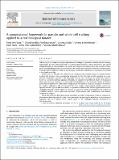Files in this item
A computational framework for particle and whole cell tracking applied to a real biological dataset
Item metadata
| dc.contributor.author | Yang, Feng Wei | |
| dc.contributor.author | Venkataraman, Chandrasekhar | |
| dc.contributor.author | Styles, Vanessa | |
| dc.contributor.author | Kuttenberger, Verena | |
| dc.contributor.author | Horn, Elias | |
| dc.contributor.author | von Guttenberg, Zeno | |
| dc.contributor.author | Madzvamuse, Anotida | |
| dc.date.accessioned | 2016-05-12T10:30:05Z | |
| dc.date.available | 2016-05-12T10:30:05Z | |
| dc.date.issued | 2016-05-24 | |
| dc.identifier | 240890395 | |
| dc.identifier | 353e91d9-ce48-4b12-bf3a-450dd196f872 | |
| dc.identifier | 84977943169 | |
| dc.identifier | 000376840800005 | |
| dc.identifier.citation | Yang , F W , Venkataraman , C , Styles , V , Kuttenberger , V , Horn , E , von Guttenberg , Z & Madzvamuse , A 2016 , ' A computational framework for particle and whole cell tracking applied to a real biological dataset ' , Journal of Biomechanics , vol. 49 , no. 8 , pp. 1290-1304 . https://doi.org/10.1016/j.jbiomech.2016.02.008 | en |
| dc.identifier.issn | 0021-9290 | |
| dc.identifier.uri | https://hdl.handle.net/10023/8783 | |
| dc.description | FY, CV, VS and AM acknowledge support from the Leverhulme Trust Research Project Grant (RPG-2014-149). The work of CV, VS and AM was partially supported by the Engineering and Physical Sciences Research Council, UK grant (EP/J016780/1). This work (AM, ZG, EH, RZ) has also received funding from the European Union's Horizon 2020 research and innovation programme under the Marie Sklodowska-Curie grant agreement No 642866. The work of CV is partially supported by an EPSRC Impact Accelerator Account award. | en |
| dc.description.abstract | Cell tracking is becoming increasingly important in cell biology as it provides a valuable tool for analysing experimental data and hence furthering our understanding of dynamic cellular phenomena. The advent of high-throughput, high-resolution microscopy and imaging techniques means that a wealth of large data is routinely generated in many laboratories. Due to the sheer magnitude of the data involved manual tracking is often cumbersome and the development of computer algorithms for automated cell tracking is thus highly desirable. In this work, we describe two approaches for automated cell tracking. Firstly, we consider particle tracking. We propose a few segmentation techniques for the detection of cells migrating in a non-uniform background, centroids of the segmented cells are then calculated and linked from frame to frame via a nearest-neighbour approach. Secondly, we consider the problem of whole cell tracking in which one wishes to reconstruct in time whole cell morphologies. Our approach is based on fitting a mathematical model to the experimental imaging data with the goal being that the physics encoded in the model is rejected in the reconstructed data. The resulting mathematical problem involves the optimal control of a phase-field formulation of a geometric evolution law. Efficient approximation of this challenging optimal control problem is achieved via advanced numerical methods for the solution of semilinear parabolic partial differential equations (PDEs) coupled with parallelisation and adaptive resolution techniques. Along with a detailed description of our algorithms, a number of simulation results are reported on. We focus on illustrating the effectivity of our approaches by applying the algorithms to the tracking of migrating cells in a dataset which reflects many of the challenges typically encountered in microscopy data. | |
| dc.format.extent | 15 | |
| dc.format.extent | 3499379 | |
| dc.language.iso | eng | |
| dc.relation.ispartof | Journal of Biomechanics | en |
| dc.subject | Cell tracking | en |
| dc.subject | Segmentation | en |
| dc.subject | Particle tracking | en |
| dc.subject | Optimal control | en |
| dc.subject | Phase-contrast microscopy | en |
| dc.subject | Geometric evolution law | en |
| dc.subject | QA Mathematics | en |
| dc.subject | QH301 Biology | en |
| dc.subject | NDAS | en |
| dc.subject.lcc | QA | en |
| dc.subject.lcc | QH301 | en |
| dc.title | A computational framework for particle and whole cell tracking applied to a real biological dataset | en |
| dc.type | Journal article | en |
| dc.contributor.sponsor | EPSRC | en |
| dc.contributor.institution | University of St Andrews. Applied Mathematics | en |
| dc.identifier.doi | 10.1016/j.jbiomech.2016.02.008 | |
| dc.description.status | Peer reviewed | en |
| dc.identifier.grantnumber | N/A | en |
This item appears in the following Collection(s)
Items in the St Andrews Research Repository are protected by copyright, with all rights reserved, unless otherwise indicated.

